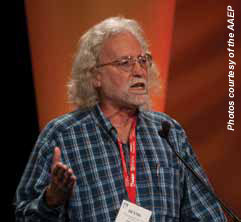Clinical practitioners keep abreast of research
American Association of Equine Practitioners members who came Dec. 4-8 to Baltimore to learn about the latest clinical research and medical advancements regarding horses shouldn't have come away disappointed.
Dr. Dennis E. Brooks of the University of Florida College of Veterinary Medicine gave this year's Frank J. Milne lecture, titled "Catastrophic ocular surface failure in the horse." In his talk, he emphasized that practitioners should not accept the "dogma" they've been taught, or at least that they should consider alternatives and ask themselves why they prescribe the treatments they do.

"I was taught more than 30 years ago that the horse eye heals poorly. What I have learned through much trial and failure, and some science, is that the horse eye has very powerful ocular healing capabilities. The uniqueness of the horse seems to be that the diseases that attack the horse eye are some of the strongest, most complicated, and most debilitating conditions in all of ophthalmology," he wrote in the proceedings. "We continue to attempt to understand and use the horse's innate ocular healing capabilities to not inhibit this endogenous healing ability with our 'treatments.' My goal is finding new ways to treat corneal ulcers so we have fewer blind horses."
Ocular surface failure most often manifests as corneal ulceration in horses, he said, and 90 percent of the time, veterinarians should be able to get the condition under control. That's partly because the horse cornea has limited ways to react when injured, and practitioners should take advantage of that knowledge when diagnosing ocular surface failure.
The horse's cornea is very active immunologically, but it's not fully understood how, just yet. For example, a study recently demonstrated that the tear replacement rate for horses is seven minutes. This is a scary number, Dr. Brooks said, because that means eyedrops used for a corneal ulcer are not going to last long.
The medical standards of care have changed for treating ocular ulcers. It's not just antibiotics and uveitis, Dr. Brooks said. It's that and working with the tears, because something in the horse's tears attracts polymorphonuclear cells to sites of corneal injury, which help heal the wound.
He continued, "Healing starts peripherally, and unfortunately, some of the drugs we use slow this down. A horse's corneas should heal at a rate of about 1 millimeter a day."
Dr. Brooks is professor of ophthalmology and the ophthalmology service chief at the UF veterinary college. He is a diplomate with the American College of Veterinary Ophthalmologists and is widely regarded as an authority on infectious keratitis, corneal transplantation, and glaucoma in horses.
Other experts in the fields of equine reproduction, surgery, and medicine provided research highlights from 2010 during the Kester News Hour.
Dr. Margo L. MacPherson discussed results from a few studies that looked at how to optimize reproduction in horses. "Models to predict reproductive success in horses" (Animal Reproduction Science 2010;121:126–127) found that factors associated with improved pregnancy rates were younger-aged mares (no older than 14), mares bred earlier in the season (February to April), mares' beginning status (foaling mares), stallion choice, and reinforcement breeding (usually in live mating situations).
Another study, "Impact of reproductive efficiency over time and mare financial value on economic returns among Thoroughbred mares in central Kentucky" (Equine Veterinary Journal 2009;41:889–894) found that 63 percent of mares missed producing a foal a year. The mean time before the mare failed to produce a foal was 3.4 years. For a seven-year investment period, mares must produce foals for six of those years for a positive financial return.

Dr. Stephen M. Reed noted that the American College of Veterinary Internal Medicine published a consensus statement on equine metabolic syndrome (Journal of Veterinary Internal Medicine 2010;24:467–475). Reviewers compiled information that showed these horses would likely have insulin resistance, obesity, and laminitis. Increasing physical activity is critical for horses because EMS is so closely linked with obesity, he said.
"Getting owner compliance is difficult for EMS, particularly restricting feed access," Dr. Reed said. "Get owners to be aware they are not being kind to their horse when they put them outside at certain times of year. Maybe on a dry lot is where they should go, or (they should) have a grazing muzzle."
Researchers at the University of Minnesota, Oklahoma State University, and elsewhere are currently investigating the disease occurrence and genetics of EMS. The website www.cvm.umn.edu/equinegenetics/ems has more information on the topic.
And finally, in his roundup of horse racing-related studies, Dr. Scott E. Palmer touched on the hot-button issue of the potent anti-inflammatory agents—intra-articular corticosteriods—in racing Thoroughbreds.
Scientific research has demonstrated that most of the commonly used intra-articular corticosteroids produce prolonged periods of therapeutic effect, measured in weeks. Nevertheless, these products are being used very close to race day in some cases, and the lack of control of such practices is not in the best interest of horses, according to the AAEP's guidelines for racehorse veterinarians.
Dr. Palmer cited "The use of intra-articular corticosteroids in the horse: What is known on a scientific basis?" by Dr. C. Wayne McIlwraith (Equine Veterinary Journal 2010;42:563–571). The review article dealt with matters such as catastrophic injury, articular cartilage degradation and the development of osteoarthritis, as well as the timing of injection relative to racing.
In other Kester News Hour news, Dr. MacPherson saw her last year in the anchor's seat. She will be replaced this year on the reproduction beat by Dr. Patrick M. McCue, a professor at the Colorado State University College of Veterinary Medicine & Biomedical Sciences.
For a full list of scientific articles referenced during the Kester News Hour, visit www.aaep.org/Kester_2010.htm.